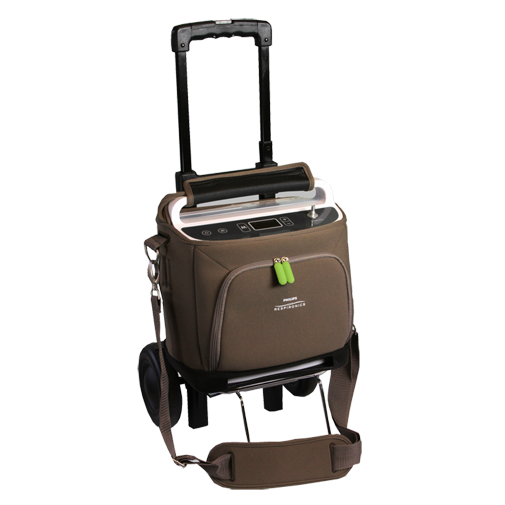6 Simple Techniques For Portable Oxygen Concentrators
Wiki Article
The Ultimate Guide To Portable Oxygen Concentrators
Table of ContentsThings about Portable Oxygen Concentrators8 Simple Techniques For Portable Oxygen ConcentratorsPortable Oxygen Concentrators - QuestionsIndicators on Portable Oxygen Concentrators You Should Know
Stationary oxygen concentrators were when the criterion, but these containers might weigh 50 extra pounds and were extremely cumbersome (Portable Oxygen Concentrators). Now, portable oxygen concentrators finish the job, and they can match a purse or bag! The only point you must maintain in mind is that portable concentrators have a lot more limited oxygen distribution capacitiesThere are two primary kinds of mobile oxygen concentrators: pulse dosage and constant circulation. As the name suggests, pulse dose concentrators give oxygen intermittently, only activating when you breathe in. This sort of device is normally recommended for COPD people with restricted oxygen needs, as the amount of O2 that a pulse dose concentrator can deliver is relatively low.
This device can supply up to 3,000 m, L of oxygen every min, while pulse dosage devices tend to cover out at 1250 m, L. Continual circulation devices are the go-to for the majority of COPD individuals, as they're optimal for people that require 2 to 5 litres of oxygen a min.
Currently that you have this guide to the different kinds of portable oxygen equipments, pick the very best device with the help of your medical professional. You can explore our blogs to get more information about the types of portable oxygen available and our various other products, like tubes and cannulas. Or you can contact us directly with any type of specific concerns you might have.
The Of Portable Oxygen Concentrators
We realize Americans utilize residential versions in home care circumstances. We wondered just how well these portable oxygen concentrators would work in medical facilities. POC concentrators increase the proportion of oxygen in ambient air individuals breathe in, whenever they require a boost. Private-use ones are little enough to lug about, and may help prevent the demand to go to overloaded clinics and medical facilities.When it involves mobile oxygen treatment, there are two primary alternatives for shipment. These are portable oxygen cyndrical tubes which include compressed oxygen gas, or oxygen concentrators, which make use of a battery powered system to compress and filter air, in order to develop a consistent supply of concentrated oxygen. In this post, AMS Composite Cylinders Technical Supervisor, Tony Morrin, contrasts both, looking at the benefits and drawbacks of each oxygen shipment system for NHS clinical oxygen individuals in regards to individual freedom.

Mobile Oxygen Concentrator Oxygen pureness is continually higher when provided from cyndrical tubes it never ever drops listed below 99. Whilst oxygen concentrators can be useful for clients that require a reduced flow of oxygen, cylinders provide greater focus that can be more appropriate for patients with high flow demands.
Recommended Site
Fascination About Portable Oxygen Concentrators
Both systems need the individual to lug about equipment. For cylinders, this will consist of lugging a bag (and sometimes a trolley) and for portable oxygen concentrators this will certainly consist of the bag, trolley and power battery charger. Weight smart, portable oxygen concentrators can be equivalent in weight, or often, lighter than standard aluminium cylinder systems.
They will need to boost considerably if they are to provide the very same degree of performance as equivalent composite cyndrical tubes. Oxygen always lugs a safety and security risk. On one hand, must cylinders spring a leak, they can develop an oxygen rich setting that can lead to a boost in fire threat.

The distinction is that there are substantial upfront prices to buying a mobile oxygen concentrator, yet reduced running prices making use of cylinders allows the buyer to spread out the cost over an extensive time period. One minor drawback of a mobile oxygen concentrator is the noise mobile systems make a considerable quantity of noise during operation, which many individuals discover disruptive.
Our Portable Oxygen Concentrators Ideas

Our top notch carbon composite cylinders provide high stress (300 Bar), low weight, and NLL (Non-Limited Life) efficiency, and are accredited for usage worldwide. Further info regarding AMS Composite Cylinders Ltd can be found at .
Oxygen concentrators are created with individual movement in mind. Whether it's a desktop variation for home use or a smaller sized, lightweight version for on-the-go, see page these devices enable clients to relocate freely without being tethered to a stationary unit. Especially for the ones specifically made for transportability, patients can bring them around, helping with travel and day-to-day tasks easily.
Among the significant benefits of using an oxygen concentrator is the removal of the regular demand to fill up oxygen containers. This not just lowers the logistical obstacles and persistent costs connected with refills yet also ensures that the customer has a much more predictable and consistent source of oxygen. Oxygen concentrators are designed to fit effortlessly right into the home atmosphere.
Report this wiki page